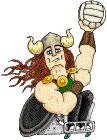This area has been created to give future classifiers
and players information on classification.
To
play wheelchair rugby a person must be classified into a specific class.
The classification process consists of a formal strength and functional
evaluation by certified USQRA classifiers who are licensed physical therapists,
occupational therapists or physicians.
Classification Highlights
Who
can be a classifier: Any individual (PT, OT, MD) with formal training in
neuromuscular evaluation and demonstrates competence in manual muscle testing
of the upper extremities, trunk, and lower extremities can become a wheelchair
rugby classifier. One must also have the knowledge or willingness to learn
about wheelchair sports, specifically rugby.
Classifier Certification:
There are four levels of certification for classifiers.
| Level I |
- must attend a basic classification workshop
- have experience with neuromuscular evaluations
|
Level II |
- be able to complete a bench test and
explain findings to level III/IV classifiers and players.
- demonstrates contact hours with wheelchaair rugby
|
| Level III |
- performs complete bench test (strength
& functional), provides explanation to classifiers, players,
coaches, RAC and PCB members
- instructs at a basic classification workshop
- actively participates at the Regional level
|
| Level IV |
- chief classifier for Regionals/Sectionals
- involved with 2 protests
- ongoing involvement with supervision, edducation and training of classifiers
- participates at the international level |
If you have a question about Classification, send e-mail
to classification@quadrugby.com
Tournament Classification
For
a tournament to have a valid classification panel, a team of 3 classifiers
must be present. For regional tournaments, one of the classifiers must
be a level IV classifier to give an athlete's final classification. At Regionals/Sectionals,
a level IV classifier must be present. At Nationals, two level IV classifiers
must be present.
Player Classification
Wheelchair rugby players are classed into one of
seven classes: 0.5, 1.0, 1.5, 2.0, 2.5, 3.0, 3.5
With the higher classes going to those players
that have higher functional levels and the lower class players are players
with less function. There are three off the court components used to
determine players’ classification:
| Bench Test - |
a muscle test is performed on all upper extremity musculature, in addition to an examination
of range of motion, tone, and sensation
|
Functional Trunk Test - |
assessment
of the trunk and lower extremities in all planes and situations, this may
include a manual muscle test of the trunk muscles
|
| Functional Movement Test - |
pushing, turning, stopping, starting, hoolding your chair against resistance,
dribbling, passing, rimming and transferring are some of the functional
skills that may be evaluated. A player will also be evaluated on the court,
while playing, to help determine which class he/she falls into. |
There are functional characteristics and identified
muscle grades for each player class. Through the testing as summarized
above the characteristics and muscle strengths are determined and a player
is given a class that is agreed upon by the full panel of classifiers.
If a full board is not present a player may be given a temporary class
that is good until the player is at a tournament with a full classification
board when he must get a formal class. If the panel is unable to come to
a unanimous decision or if the panel would like other classifiers to evaluate
a player, a review class is given to a player (i.e. 3.0R). This player
would then be looked at by another panel while playing under the class
he was given by the first panel.
A Formal Protest
If
a player does not agree with his final classification or if a team or player
disagrees with another player’s class they may submit a formal protest.
This is done by obtaining a protest form from a classifier, submitting
it in a timely manner at a tournament with a valid classification panel
along with a nominal fee that will be returned to you if you are found
to be right in the protest.
For more information check out the International Wheelchair Rugby Federation.
|

![]()